How To Nymph For Trout: FULL ARTICLE
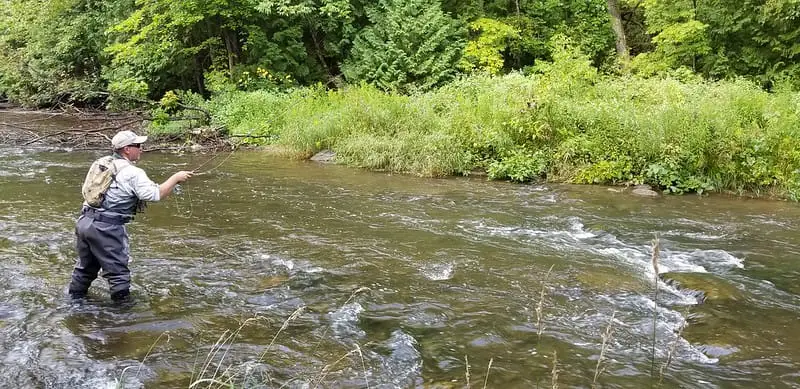
This is the FULL in-depth article on how to catch trout.
I still remember the first trout I ever caught fly fishing. I was nymphing for trout all day, and after numerous tangles, flies in trees, wind knots, and frustration, I finally got a 9-inch brown trout to eat my Gold Ribbed Hares Ear Nymph.
That was over 37 years ago, and since then, I have become one of the top fly fishing guides in my area, and I now teach people how to nymph for trout properly.
On that same section of river where I caught my first fish, using the methods taught to me by other guides and some of the world’s best competition fly anglers, it’s not uncommon for me and my clients to land 30 or 40 trout each day, including some big trout over 20 inches.
Nymphing is a fly fishing method where the angler imitates subsurface aquatic insects known as nymphs, and other food sources. Since trout feed below the surface over 90% of the time, nymphing is often the most effective method.
8 Key Elements To Effective Nymphing
- Gear: Waders help you get in positions, long rods help with mending, line control, and better presentation, as well as act like a shock absorber to protect light leaders.
- Leader Setup: Whether you are an indicator nymphing or you tight line nymph, proper leader setup is critical.
- Method: There are three good methods of nymphing. Knowing how to do all of them and then knowing when one is most effective based on the river conditions helps a lot.
- Reading The Water: Knowing where the trout should be holding and feeding is important.
- Approach: Knowing how to approach a spot so you don’t spook the trout is critical to catching the most trout possible.
- Presentation: If you can make your nymph drift as naturally as possible, it is much more likely to get eaten by feeding trout.
- Flies: I left this for last. New anglers think catching more trout is all about having better flies, but, they are wrong. Even a great fly fished poorly still won’t catch any fish.
- All Or None Mentality: I teach my students that you MUST do it all correctly, or you will struggle to catch fish. If you do a few things well, but one or two things are not good, those one or two wrong things will prevent you from catching fish. Trust me, I see this happen all the time.
I will expand on all of this below.
Introduction To Nymphing For Trout
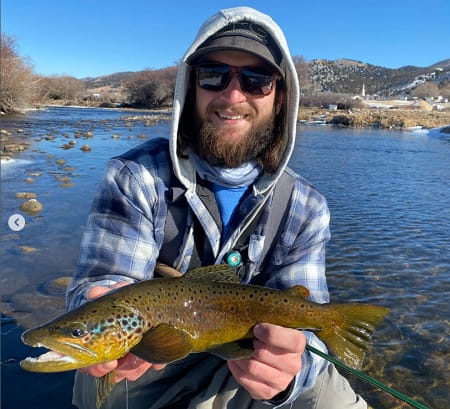
Trout spend more than 90% of the time eating below the surface, so if an angler is good at presenting their fly below the surface and deep enough, they have a greater chance of catching fish.
You also have the ability to catch trout all year long, especially during the winter when nymphing with a slower presentation is often the only way to catch trout.
What Is Nymphing?
Nymphing is a method that allows the angler to drift small imitation fly patterns known as nymphs below the surface in a way that looks natural to the trout. Often, nymphing done well is the most effective fishing technique for catching trout in the stream.
Nymphing can be done at long distances but close-range nymphing with short casts is more common.
Nymphing is also the most effective method for fishing migratory brown trout and migratory rainbow trout known as steelhead, as well as salmon fishing in rivers.
See the articles Nymphing For Steelhead, and Nymphing For Salmon if these are species you are interested in catching as well.
How To Nymph For Trout
There are many ways to nymph for trout, in fact, I teach 7 nymphing methods in my Advanced Nymphing Classes.
When and Where to Fish Nymphs
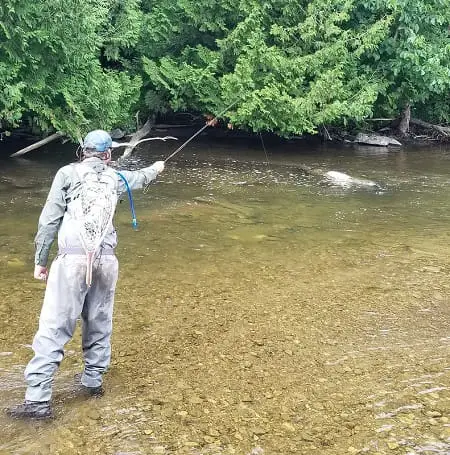
You should know when to use nymphs and my rule is “anytime is good for nymph fly fishing”.
Honestly, I tell my clients and students to be observant and see what is going on at the river. This means if the fish are feeding on the surface, try dry fly fishing, if the fish are chasing minnows or other baitfish then try streamers. If you see nothing, try nymphing for trout.
Also, nymphing is often best done in medium to fast current speeds and it excels in pocket water and shallow riffles, and pools.
What Is A Nymph?
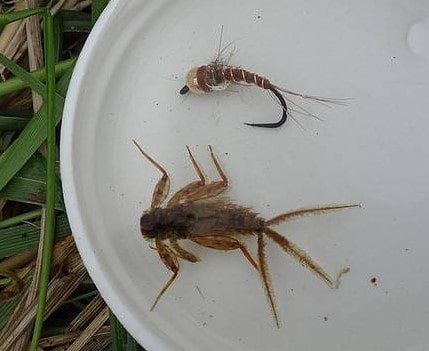
Nymphs are immature aquatic insects before they emerge, grow wings, and fly off as winged adults.
However, in fly fishing, nymph patterns can also imitate insects that never grow wings, and nymphs can also imitate fish eggs.
Nymphs could also be crustaceans, minnows, and leeches. Common nymphs are Mayflies, Stoneflies, and Caddis.
These insects are found in the river year-round making nymphing an effective year-round method.
Best Nymphs For Trout
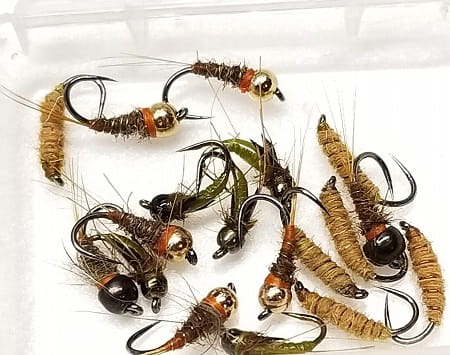
There are thousands of good nymph patterns and often the best nymph will depend on what is prevalent or what is hatching in the river you fish.
You should consider looking over the hatch charts for your area to see the types and sizes of prevalent mayflies, stoneflies, and caddisflies for your area.
There are some great nymph fly patterns that tend to work almost everywhere and you will see these types of nymphs in the boxes of guides and competition fly anglers.
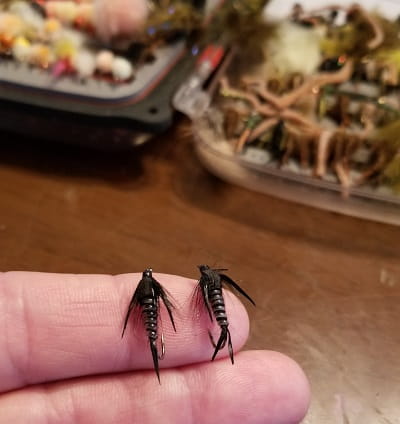
Many anglers and guides will have favorite nymphs and a range of sizes from small size 24 midges to large size 2 stonefly nymphs.
Since you can’t see what’s underwater or what the trout are eating, to find out what nymphs are prevalent in your river lift up a rock or two to see what’s hiding on the bottom of the rocks.
These are my favorite nymphs for trout are:
- Pheasant Tail Nymph: Whether bead head or non-bead head, the pheasant tail nymph imitates nymphs of many species. Have this nymph in multiple sizes and in light brown, dark brown, and black.
- Frenchie Nymph: A variation of the pheasant tail nymph used in competitions but super effective anywhere.
- Polish Pheasant Tail Nymph: Another deadly good variation of the Pheasant tail nymph is usually used with tight line nymphing.
- Hares Ear Nymph: A great nymph pattern that looks buggy and imitates nymphs well. Also, variations like the Hare’s Ear Tag Nymph are excellent
- Prince Nymph
- Zebra Midge
- Copper John
- Walts Worm and Sext Walts Worm: This is a unique fly that could imitate nymphs or cased caddis. Either way, trout love this fly pattern.
- Caddis Larvae: Many streams will have caddis so a good caddis pattern will catch fish. The Euro nymphing version and one of my favorites are the green and tan Czech Nymph.
- Micro Bugger: Just like the Woolly Bugger but this one is half an inch to 1.5 inches long. tied in black, olive, white, tan, and brown.
- San Juan Worm: every angler should have a good worm pattern in brown, red, and pink in their box.
- Egg Fly: Eggs can be very good nymph patterns especially if there are spawning fish in the area.
Bead Head VS Non-Bead Head Nymphs
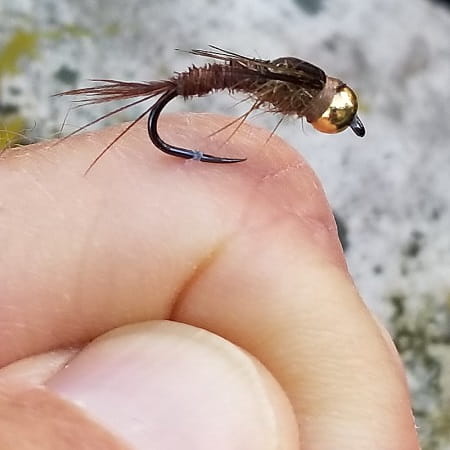
I get this question from new fly fishermen a lot. When someone sees a shiny gold or silver bead on my fly they wonder if that really works.
The answer is yes, metallic bead head flies tend to work better than nymphs with no beads.
For some reason, the beads actually attract the attention of trout and that’s a good thing. If you look in the fly boxes of guides and top competition fly anglers, I’d bet over 75% of their nymphs will have beadheads.
However, there are times, often in high sun, or in clear water when the trout will prefer flies that are not shiny with beads.
Metalic beads are usually made of brass which is fairly lightweight and is added primarily as an attractor. Or the beads are made of tungsten which is heavier than lead and these are the ones most competition anglers prefer.
Fly Fishing Gear For Nymphing
If you are planning on Nymphing for trout you should know the appropriate fly fishing gear, or the better gear to use.
Fly Rods
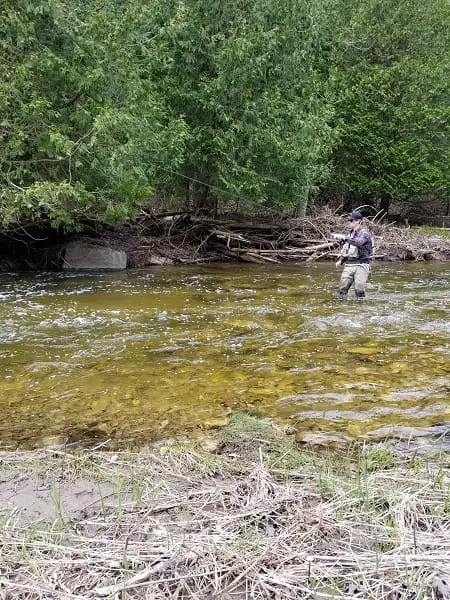
You could use any fly rod for nymphing but most anglers, myself included prefer to use a longer fly rod over 9 feet long. For some methods, a 10-foot or even an 11-foot rod is preferred.
I always recommend a 10-foot rod if you want a dedicated nymphing rod or a 9-foot rod if you want a rod for multi-use.
Also, the rod weight should be 4 weight to 6 weights for medium to large waters or for bigger trout between 4 and 8 pounds, or a 2 to 3-weight fly rod for small to medium rivers under 60 feet wide or for smaller trout under 4 pounds.
I have also found the longer 10 and 11-weight rods are better in 2 to 4-weight sizes.
The Fly Reel
A good fly reel with an enclosed disc drag system is best for most anglers and is preferred for beginners. If you are a beginner avoid click-and-pawl reels.
Fly Line
Any general-purpose weight-forward fly line will be good for nymphing. There are specialty nymphing lines available are a good option if you are putting it on a dedicated nymphing rod.
Leader
A standard tapered leader of 9 feet and usually 2x to 5x will work for nymph fishing. For some of the specialty nymphing methods below you will need to make your own leader.
Tippet
For small trout, go with as light a tippet as possible, which is usually 6X. For bigger trout, I still go with the lightest tippet possible without breaking off regularly. Thinner tippets have a lot of advantages.
Thinner tippets allow the fly to sink faster, they don’t get pushed or dragged by the current as much so your fly moves at a more natural speed. Lighter tippets are also seen less by the trout.
Indicators
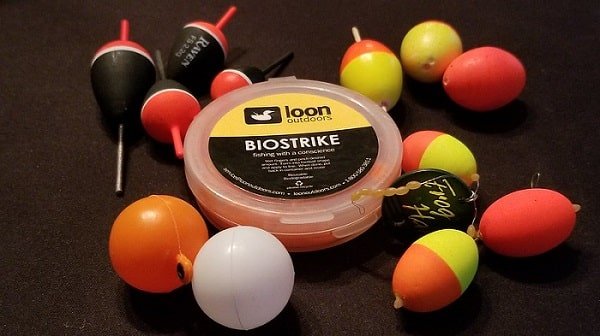
Indicators are basically mini bobbers and they help the angler detect the bite of the trout.
Advanced anglers will also use them to control the speed of the fly and the angle of the leader for a better presentation.
I prefer and discuss the football-shaped bi-color indicators or the yarn indicators in my article The Best Indicators For Fly Fishing.
Other Gear
Other river fishing gear you should have to make catching, landing, and releasing trout are:
- Waders
- Vest Or Packs
- Forceps
- Nippers
- Thermometer
- Net
- Polarized glasses: I would catch far less trout without polarized glasses and I believe they are an essential tool for river fishing.
Polarized Glasses
Polarized glasses are a must for nymph fishing for trout and they will make you more productive. By cutting the glare on the surface, they allow you to see underwater holding spots, bottom contours, rocks, and snags like branches or logs.
They might even enable you to see big fish holding or feeding. I have guided my clients to many big hungry trout simply because I was able to see the fish.
They also make it easier for you when looking into the water for immature insects.
Seeing or recognizing the feeding lane is also easier with less glare on the water.
Another big benefit of polarized glasses is they enable you to see the bottom in fast water so you can cross safely. Even in high water, I scan the river from bank to bank to determine the safest route to get across the river.
GUIDE TIP: Do NOT cross in high water unless you are experienced.
Nymphing Techniques
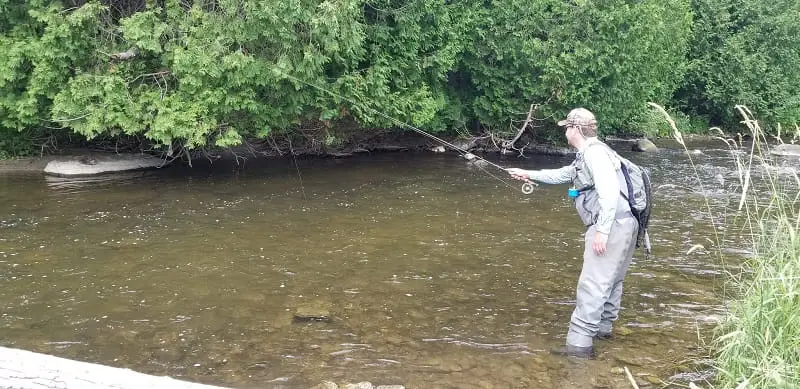
The 7 nymphing techniques I teach in my advanced nymphing class are listed below. However, you only need 2 methods to be consistently successful on the river and those two techniques are Indicator Fishing, and TightLine Nymphing which is also known as Euro Nymphing, or Modern Nymphing.
The 7 Nymphing Techniques Are:
- Indicator Nymphing
- High Sticking or High Stick Nymphing
- Bounce Nymphing
- Czech Nymphing
- Polish Nymphing
- Spanish Nymphing
- French Nymphing
Wet Fly Swing
Some anglers consider the wet fly a nymph or the wet fly swing a nymphing method and although it does use nymphs and wet flies, it’s not really nymphing. I’ll be adding an article on this method in 2023.
Indicator Nymphing
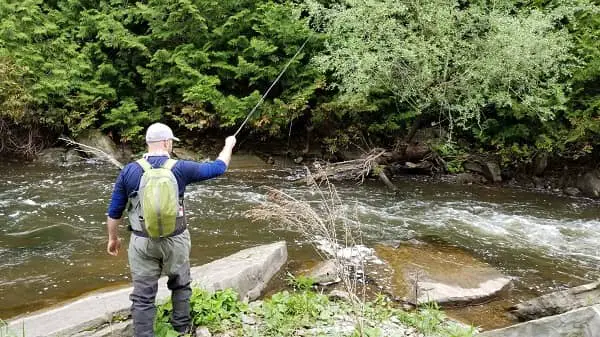
Indicator nymphing is a method I use and recommend a lot.
With indicator nymphing, you are drifting your nymph below what is known as a strike indicator which floats on the surface, and you are using the strike indicator as bite detection.
Indicator fishing is the most popular of all nymph fishing techniques and has been used for decades. However, although it is a good method of nymph fly fishing, it is not always the best method.
Indicator fishing is often the best nymphing technique for slow currents, deeper water areas, or big spots. It is also the best method in heavy winds and when fishing long distances.
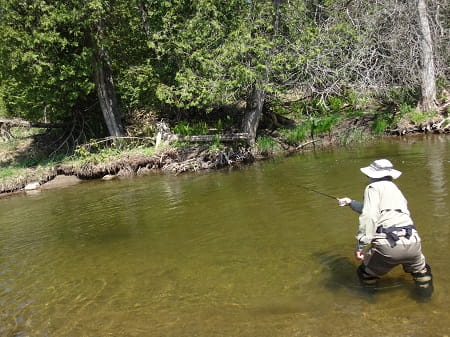
Indicator fishing is also the preferred method of anglers learning to fly fish and it makes it easier to cover all levels of the water column.
More advanced anglers will use tight line methods I mention below if the conditions are best for it.
Downstream and upstream Indictor fishing nymphs works well which also makes this method versatile.
Most anglers will cast their indicator nymphing rig up the river on a 45-degree angle out, let it drift past them, and either pull it out when the line tightens or they will feed the fly line out and try to extend the downstream drift.
If the indicator stops, twitches, or pulls underwater set the hook.
Indicator nymphing is usually done with non-weighted flies and anglers use added weight known as split shot to get the flies down. The deeper and faster the water the more weight is required. See the weights guides use at best Weigths For Fly Fishing.
The indicator can be adjusted and slid up or down the leader to get the flies at the proper depth. Since most fish are near the bottom it’s ideal to adjust your strike indicators to keep your flies down and where the fish are feeding.
You can use two flies or even three flies to cover different levels of the water column. The upper fly can even be within a foot of the surface while the bottom fly can be inches from the bottom of the river.
In some cases, large dry flies can be used as strike indicators which is known as a dry dropper nymph fish rig.
Indicator fishing is usually done with a floating line and a tapered leader.
Beginner and intermediate anglers use the indicator to adjust the depth and to detect a strike, whereas advanced indicator nymph anglers will also use the indicator to control the speed of the nymph which can result in catching ten times more trout.
Advanced anglers are good at not dragging the fly with the indicator and learn to control their drifts better.
I discuss beginner to advanced indicator nymphing techniques and the best indicators to use in my article Indicator Fishing: How Guides Do It.
Tight Line Nymphing
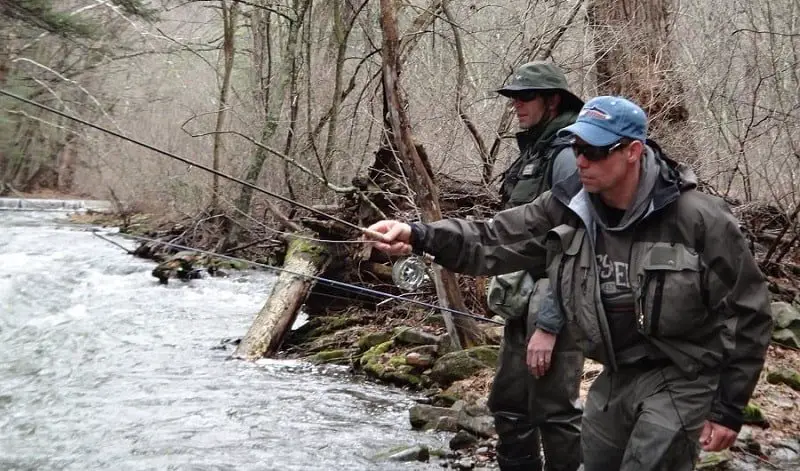
Tight line nymphing has been around longer than indicator nymphing and it started with what was known as high sticking.
Now, there are more advanced and more effective methods and it’s these methods you will see guides, advanced anglers, and competition fly anglers using the most.
Tight line fishing allows the fly angler to get a better dead drift and is better in shallow water. Dead drifting, also known as drag-free drift means the flies drift naturally and at the speed of the natural nymphs.
Matching the same speed as the other bugs means a lot more fish landed.
High Stick Nymphing
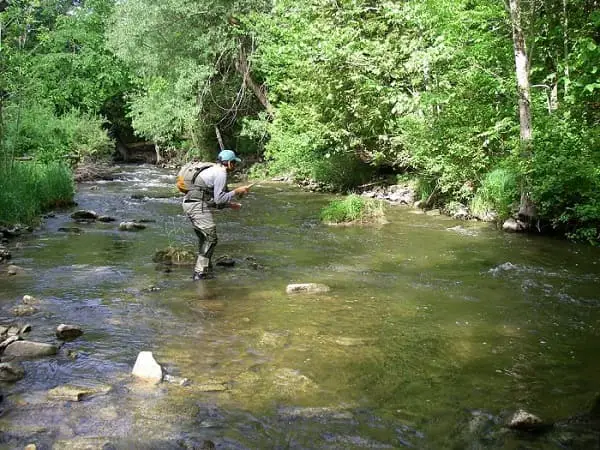
High stick nymphing, also known as high sticking, is when you use a short cast or you flip your fly out and up the river with a short amount of fly line, (less than 10 feet and as little as 1 foot of line), and you allow your fly to sink while you keep your rod tip high and your leader fairly tight.
You use 1 or 2 flies, and add some spit shot weights about 12 to 24 inches up the line to get the flies down. You use a 9 to 11-foot total leader length, you have no indicator on the leader, so if the fish bites your fly you hope to feel the bite or see the leader twitch or pull which signals a bite.
It’s a fairly simple method to use, but bite detection is difficult for newer fly fishermen which is why most anglers and guides prefer indicator nymph fly fishing.
I do not recommend this method since more modern variations of this method are more effective.
Euro Nymphing
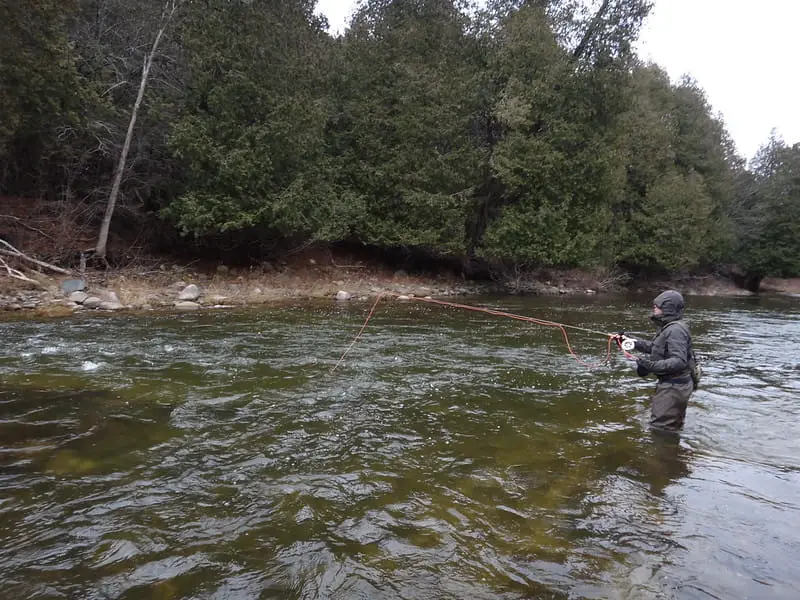
Euro nymphing is likely the newest of the trout nymphing methods and I still remember telling my clients for the first 10 years that I used this method (2006 and 2016) that I was lucky if I saw 1 or 2 anglers a year using it, and that was me being on the water for over 300 days a year.
If I did see someone using it, they were either a member of the National Fly Fishing Team or were one of my past clients. Even all the river guides in my area didn’t use it and some still don’t.
This method was nearly unheard of back then, but national competitors knew that if they did not use this method, they could not compete and win against other anglers that did.
This method is so effective that my more advanced clients would tell me they went from 5 to 10 trout a day on average to over 30 trout a day on average.
I’ve heard anglers say this method is only for small fish, but, my clients tell me that they were lucky if they hooked 1 trout over 20 inches a year, to hooking multiple trout a day over 20 inches consistently once they perfected their Euro Nymphing skills.
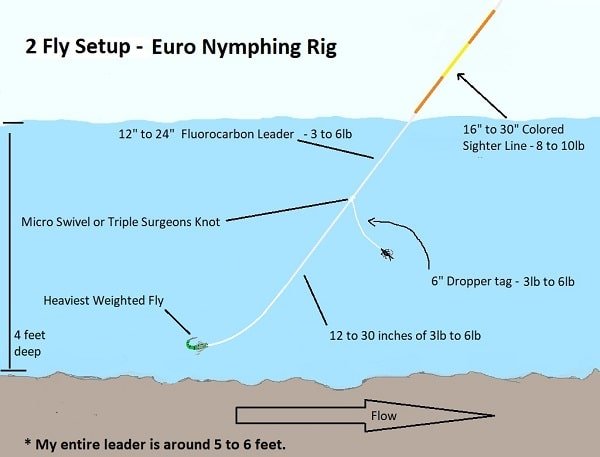
The idea behind Euro nymphing was to fish similar to traditional high stick nymphing with a high rod and short line and primarily using just the leader, except there is a 12 to 24-inch colored piece of mono line added about 4 to 6 feet up from the flies and situated in the mid-section of the leader.
And with Euro Nymphing you use a weighted fly or two with no split shot weights on the leader or tippet.
The added colored line is called the “Sighter” and it provides the angler the advantage of controlling depth of the flies better, controlling the speed of the flies better, and detecting subtle strikes far better.
The addition of the weighted flies gets your flies deeper, but it also keeps the line tight from the fly to the sighter and to the tip of the rod, which greatly improves strike detection.
Euro nymphing is a broad term and can mean many things with the basic being a short line, a sighter, and a weighted fly. But, Euro nymphing comes in many variations with the original variation being Polish Nymphing, then came Czech Nymphing which kind of popularized Euro Nymphing, then came French Nymphing and Spanish Nymphing.
Each of these variations serves a purpose in different types of water.
The Spanish and French are known to be the hardest to beat in the world fly fishing competitions and their methods are exceptionally effective in the right types of water.
Modern Nymphing or Tight Line Nymphing
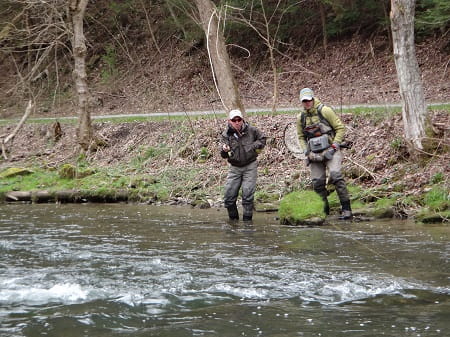
Some anglers and guides will mix these methods to create their own versions of Euro Nymphing that work best for them on their local rivers.
They call this Modern Nymphing or Tight Line Nymphing.
I have said to many anglers that you could go out with 10 different guides to learn Euro Nymphing and you could see 10 different versions.
I actually trained with 5 times World Fly Fishing Champion David Arcay and Multi-medal winning competition angler and Team USA coach George Daniel and I had them show me their variations, which were many.
Upstream With No Indicators
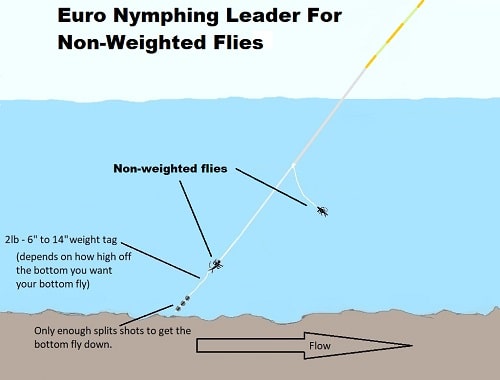
These Euro and Modern Nymphing methods are usually an upstream with no indicators approach.
There are no indicators to drag your fly faster than it should or to spook trout.
The Spanish and French nymphing methods do this the best which is partially why they are so effective.
The Spanish Nymphing method is generally an upstream and slightly across method with the possibility of letting your fly drift past you and downriver.
Direct Upstream Approach
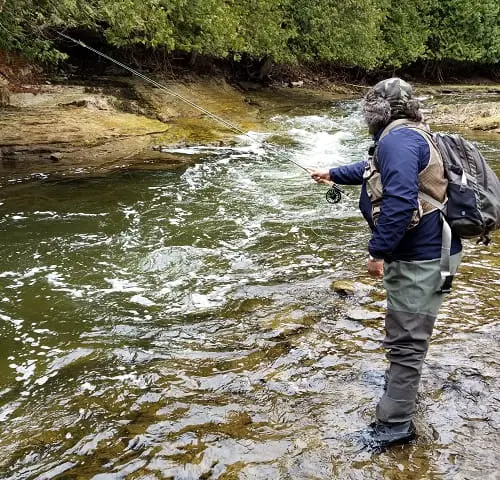
Polish nymphing and Czech Nymphing are great for deep fast water and upriver fishing.
The French nymphing method is more of a direct upstream approach without letting your fly drift past you and is more ideal in shallower water and can be used in slower water.
The idea is the angler is standing directly behind the trout at all times so they don’t see you.
With this approach, all fishing is directly above you, and since the French have won many world championships, this proves the effectiveness of this upstream approach.
Nymphing Rig
The nymphing rig can mean the entire setup which includes the rod, reel, a standard fly line, a leader, the tippet, and indicator, weights known as split shots, and flies.
The nymphing rig to some anglers means the leader and fly setup which I will discuss below.
Both the nymphing rig and the leader setup will vary depending on which style of Nymphing you want to do.
Nymphing Setup
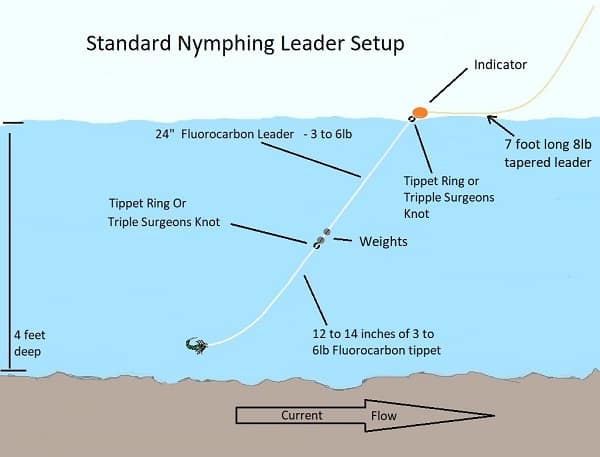
If you have read this far and now want to know how to rig a nymph fly, also known as the nymphing setup, this is it.
You should be using an indicator nymphing setup or a tight line setup and these two rigs can either be a single fly rig, or a mutli-fly rig with up to 3 flies (laws permitting).
The one fly rig is pretty basic and is best for a new fisherman.
If allowed in your area I highly recommend using two flies. I always use a two-fly setup if I am allowed. The bottom fly is known as the point fly or dropper fly.
I tend to always put my confident fly on the bottom. Confident fly means the one I believe the trout will want the most.
If you are using two flies that are weighted, normally the bottom fly should be the heavier fly unless you are fishing shallow water.
Two flies allow you to cover two levels of the water column.
Three flies should only be used by advanced anglers since one small mistake in setting the hook, or when casting can make your rig into a giant tangled-up mess.
Positioning and Angles
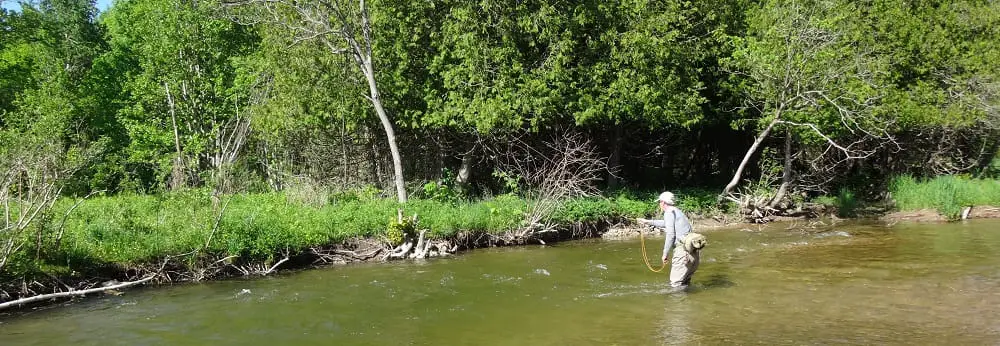
The best approach when entering a spot is to enter the spot from downriver and work your way up the spot.
Even if I’m walking downstream, I will often make a wide path around the spot I plan to fish, I will stay low, and enter the pool from below.
I generally cast upriver or up and across and fish downriver towards me.
The reason for this is to not let the trout see you and so you do not spook them.
Stealth
I honestly believe that much of the reason many anglers don’t catch many fish is simply that they spook the fish before they even make their first cast.
Trout are not smart, they are just cautious so being stealthy is very important, especially for wild fish. Stocked trout are dumber than dumb so it’s less important for them.
I know guys that will crawl to a spot so they are not spotted by the trout. They also move very slowly so they are not heard either. And guess what, these guys catch big trout that other guys never see
Presentation: The Four Elements To A Perfect Drift
I tell my clients that their goal for effective nymph fishing for trout is this: “Get your fly down and into the strike zone as fast as possible, keep it there for as long as possible, and control the speed of your fly when it’s in the strike zone”.
If you do this and you do this after you have entered the pool stealthily you will catch more fish than other anglers.
Get the Right Drift
Now if you want to catch more fish than 90% of anglers, or as many as guides do you need to get the right drift or should I say a perfect presentation?
In fact, I learned long ago that if your drift is not perfect each and every time you will struggle to catch trout consistently. This is why I named my guide business “A Perfect Drift Guide Company”.
Let’s go over that goal “Get your fly down and into the strike zone as fast as possible, keep it there for as long as possible, and control the speed of your fly when it’s in the strike zone” and I will discuss each part separately.
Depth
Since most trout hold near the bottom, it’s often best to get your flies down deep. But let’s get one thing straight first. Deep and to the bottom does not mean dragging your fly along the rocks. In fact, studies show trout feed up 87% of the time so a fly dragging on the bottom below them will get missed and not eaten.
Instead, you need to get your fly down but still keep it 6 to 16 inches off the bottom.
My rule is to get your fly as close to the fish as possible but always over their heads.
I tell a story in one of my other articles about me fishing a spot after my client already fished in and I caught 13 fish when he only caught one, and that was with the exact same fly. I did this to prove a point to him and that point was he was dragging his flies along the bottom, whereas I kept my fly over their heads all the time.
It clearly showed him the difference it made regarding how many fish it’s possible to catch if you fish right, versus fishing wrong.
Fish Deeper With Heavier Flies
You can fish deeper with heavier flies or you can add more weight if needed.
Time To Sink
It can take a few seconds or more for the fly to sink deep enough to be in the trout’s feeding zone. A few seconds could mean your indicator may have traveled 5 to 10 feet downriver which means that 5 to 10 feet of the drift is wasted. This is why I say get your fly down fast.
One of the disadvantages of using an indicator is that it drags your fly, which means the descent of your fly is slower. An advantage to Euro nymphing is there is no indicator to drag your fly so it will sink faster.
Thinner Tippets
I ran into an old client and now a competition angler who was fighting a big brown trout and it was taking him down the river. I asked if he need help to net the fish and he said yes because he was only using 8X tippet and could not put a lot of pressure on the fish.
Most anglers have never seen or even heard of 8X because it is so light that most fly shops don’t sell it. I think it’s about a 1.5lb test line.
Why so light? Competition anglers understand that the lighter and thinner the tippet the less water resistance it has, and therefore your flies will sink much quicker.
Adding Weights
Adding weights to the line is another way to get your fly down faster if you are not using flies that are already weighted.
Speed
I strongly believe that the speed of your fly is one of the most critical factors for catching fish or not catching fish.
The current at the bottom of the river, especially in water 3 feet deep or more is almost always slower than the surface current. Sometimes and often it will be 50% slower down deep. If your indicator is moving a the same speed as the bubbles (which is what most anglers try to achieve) this means your fly is moving 50% faster than all the natural insects (trout food) are moving.
Trout are not smart, they are cautious and this means if something is out of place, like an artificial fly moving at 7 miles an hour when all the insects they have been eating are moving at 3 miles per hour, they will ignore your speedy fly.
Trust me, it doesn’t matter in your fly imitates caddisflies, midges, or mayflies perfectly, if it’s moving too fast YOU WILL MISS BIG TROUT.
So control your speed by doing these things.
- Slack: Keep slack in the fly line on the water when using an indicator so it does not pull or drag the flies.
- Mending: mends or mending the line usually upriver to reposition the line so it doesn’t get caught in the current and pull the line is often the best way to prevent the line or indicator from dragging your fly too fast.
- Thin Tippet: Thin tippets not only help your fly sink but the thinner the tippet the less likely it will be pushed by the surface current which means your fly can move at a more natural speed
- Don’t Use An Indicator: one of the biggest benefits to tight line nymphing is there is no indicator pulling your fly along at the speed of the surface current.
- Trott The Indicator: Trotting simply means holding the indicator back and slowing it down slower than the surface current. This is an advanced skill but it can work very well and increase the amount of trout you catch.
Covering The Water
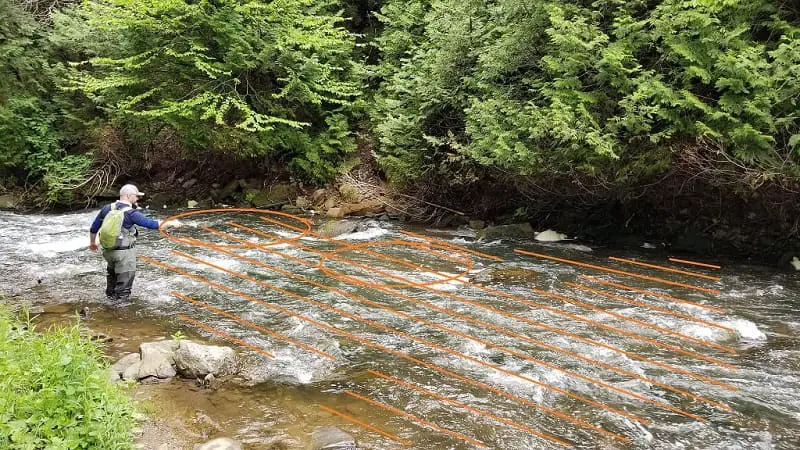
Many anglers see the bubble line which is often a good feeding lane and they fish the crap out of it. But then they forget the rest of the spot and in doing so they miss a lot of fish.
I systematically cover the water in lines and cover just about every foot of the river in spots where trout could be holding.
Competition anglers do this very well and they pull fish out of water that other anglers would have never fished.
How to Detect Nymph Strikes?
Detecting a strike is a bit of an art or skill. You may not think so but if I had a dollar for every bite I saw that my clients missed I’d probably be about $10,000.00 dollars richer.
In fact, I will see a bit two or three times in a single drift that clients miss.
So, to improve your ability to detect nymph strikes or bites try this:
- Use an Indicator to detect strikes but only when tight line nymphing is not an option.
- Use a sighter and maintain light tension to detect even the most subtle bites.
- Know What To Look For: any slow down of the line or indicator, any twitching or bouncing, any pull or sinking, set the hook.
- Keep the leader line tight: Slack in the leader or tippet will prevent you from detecting a bite so keep the leader tight with slight tension without pulling.
Setting The Hook
Setting the hook is something anglers never read about or discuss but as a guide, I know this is something you should work on.
- Set the Hook Quickly
- set on everything
- Set often and don’t hesitate
Fighting and Landing Fish
When fighting fish, especially big fish do these things:
- take your time, relax, and play them gently.
- Be sure your drag is set properly
- A lower rod tip is often better at leveraging and landing your fish
- Use a net.
Tips for Nymph Fishing Success
- Fish Deeper with Heavier Flies
- Use Tandem Nymph Rigs
- Focus on the Water Column
- Switch Up Your Flies
- Practice, Practice, Practice
How to Cast a Nymph Rig
Casting a nymphing rig is different than casting dry flies or streamer flies especially if you are using an indicator or two nymphs.
Short casts are almost always a must.
The best casts for nymphing indicators are a drag and flip cast where you literally flip the leader and a short section of line up and over your head.
Open up your casting loops so you don’t tangle your flies and indicator,
Roll casts don’t work very well with indicator rids and with tight line nymphing. Save roll cast for small pond fishing,
Understanding The Water
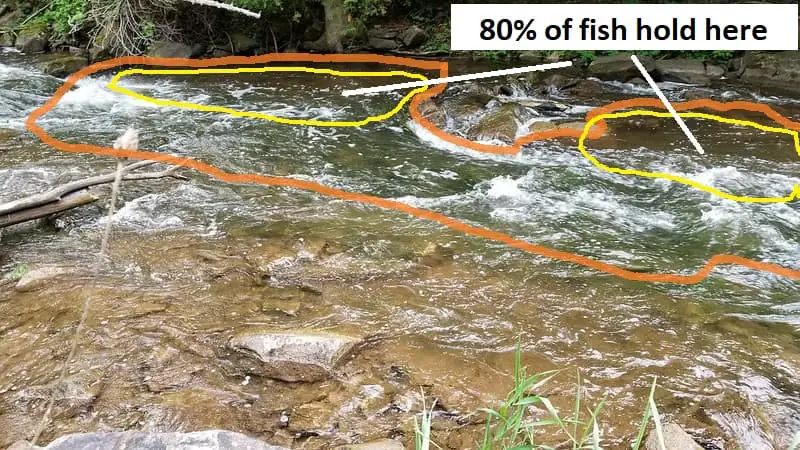
Reading the water will greatly increase your ability to catch trout.
This means locating deeper sections in the river, feeding lanes, and structures such as rocks and logs that trout will use as cover and protection.
Reading the water will help you assess the type of water so you know which method of nymphing to use based on the water type.
Nymphing For Trout Q&A
If you have any questions, or tips and advice about nymphing for trout, let me know in the comments section below.
Tight Lines,
Graham
